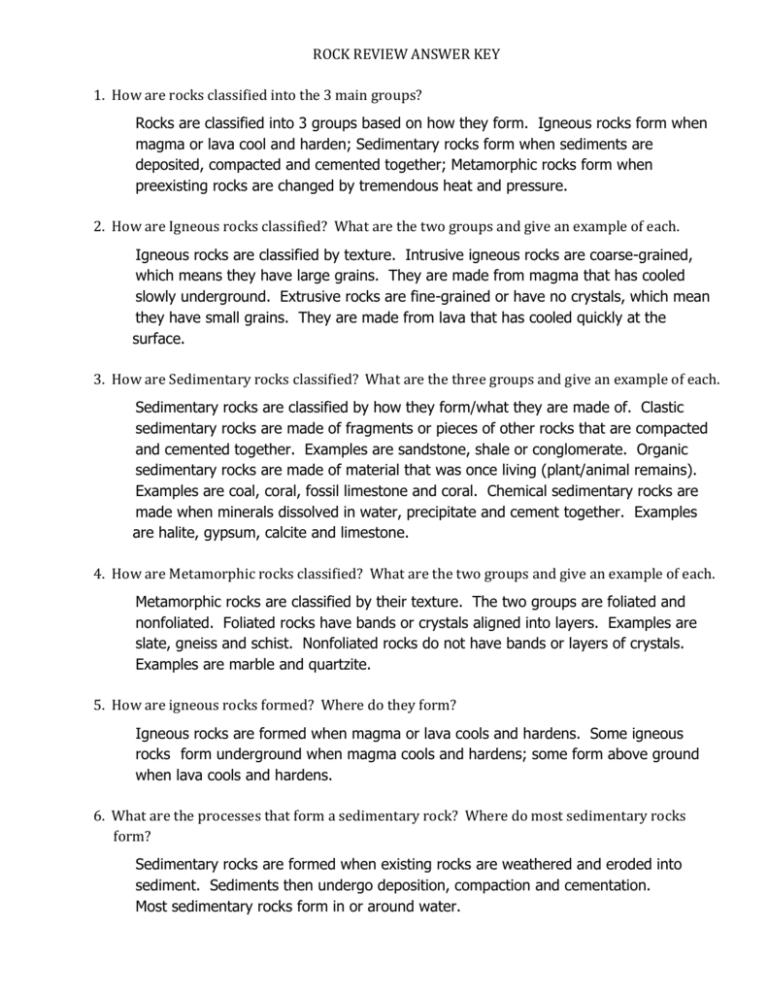ROCK REVIEW ANSWER KEY 1. How are rocks classified into the 3
advertisement

ROCK REVIEW ANSWER KEY 1. How are rocks classified into the 3 main groups? Rocks are classified into 3 groups based on how they form. Igneous rocks form when magma or lava cool and harden; Sedimentary rocks form when sediments are deposited, compacted and cemented together; Metamorphic rocks form when preexisting rocks are changed by tremendous heat and pressure. 2. How are Igneous rocks classified? What are the two groups and give an example of each. Igneous rocks are classified by texture. Intrusive igneous rocks are coarse-grained, which means they have large grains. They are made from magma that has cooled slowly underground. Extrusive rocks are fine-grained or have no crystals, which mean they have small grains. They are made from lava that has cooled quickly at the surface. 3. How are Sedimentary rocks classified? What are the three groups and give an example of each. Sedimentary rocks are classified by how they form/what they are made of. Clastic sedimentary rocks are made of fragments or pieces of other rocks that are compacted and cemented together. Examples are sandstone, shale or conglomerate. Organic sedimentary rocks are made of material that was once living (plant/animal remains). Examples are coal, coral, fossil limestone and coral. Chemical sedimentary rocks are made when minerals dissolved in water, precipitate and cement together. Examples are halite, gypsum, calcite and limestone. 4. How are Metamorphic rocks classified? What are the two groups and give an example of each. Metamorphic rocks are classified by their texture. The two groups are foliated and nonfoliated. Foliated rocks have bands or crystals aligned into layers. Examples are slate, gneiss and schist. Nonfoliated rocks do not have bands or layers of crystals. Examples are marble and quartzite. 5. How are igneous rocks formed? Where do they form? Igneous rocks are formed when magma or lava cools and hardens. Some igneous rocks form underground when magma cools and hardens; some form above ground when lava cools and hardens. 6. What are the processes that form a sedimentary rock? Where do most sedimentary rocks form? Sedimentary rocks are formed when existing rocks are weathered and eroded into sediment. Sediments then undergo deposition, compaction and cementation. Most sedimentary rocks form in or around water. 7. How do metamorphic rocks form? Where do most metamorphic rocks form? Metamorphic rocks form when existing rocks undergo heat and pressure from crustal movements, such as mountain building. Some rocks may be changed when they come in contact with magma or lava. Most Metamorphic rocks form deep underground. 8. What are the two types of weathering? Explain the difference between them and give examples. The two types of weathering are physical and chemical weathering. Physical weathering is when rocks are broken down by physical means such as abrasion (scraping away by moving water, wind, ice), plant growth, animal action, temperature changes, ice wedging. Chemical weathering is when a rock is broken down by a change in its chemical composition/structure. Chemical weathering can be caused by oxidation, acid rain, acid in groundwater or acids from living things. 9. Compare felsic and mafic igneous rock composition, color and silica content. Felsic igneous rock is composed of silicon and aluminum. It is light in color because of its high silica content. Mafic igneous rock is composed of iron and magnesium. It is dark in color because it has a low silica content. 10. List examples of parent rock and the metamorphic rock they become. Granite can become Gneiss; Shale can become Slate; Slate can become Schist Limestone can become Marble; Sandstone can become Quartzite. 11. Explain the rock cycle. You should explain the rock cycle in terms of the processes that form each rock and show how each rock can become the other types. See the diagram in the note packet.







